Kosa (Tasar) Silk Sari
As I’ve said before, I LOVE getting packages from India.
This one is something that I have been looking for for quite some time. It’s a hand-loomed pure Kosa (Tasar, or Indian Tussah) silk sari. It’s BEAUTIFUL. Just a peek, before I let you see the package opening up:
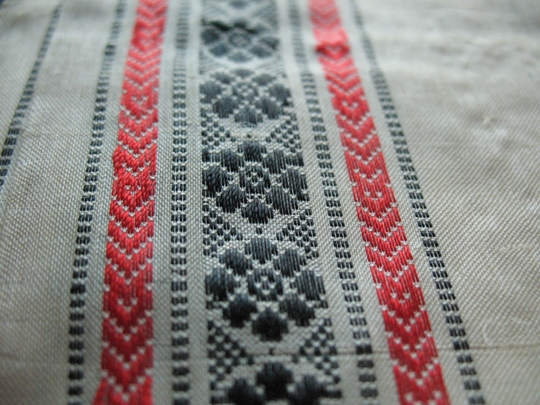
But, of course, what I see first, is this:
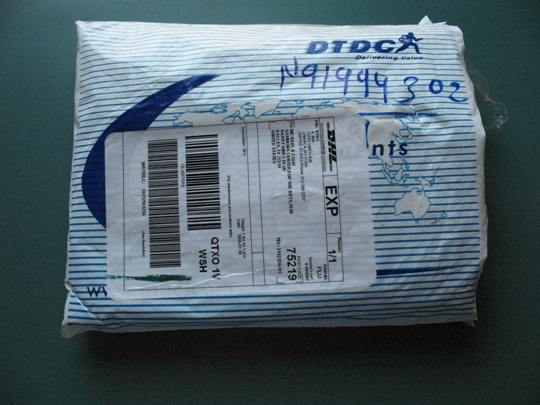
This one isn’t nearly as… intensely packaged… as some that I’ve gotten.
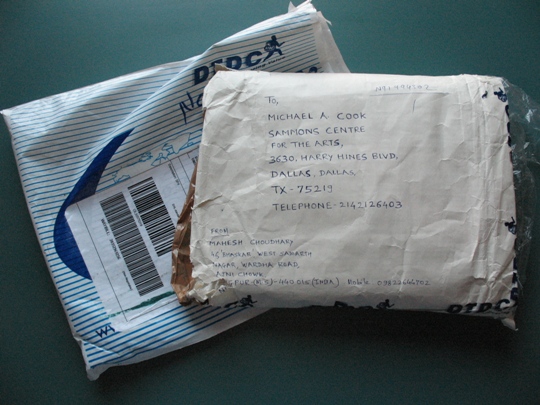
The inner packaging, with the same fiber-reinforced paper I’ve seen before.
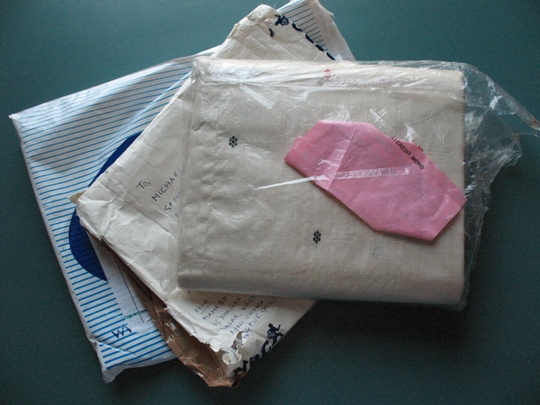
After that, there’s a plastic wrap.
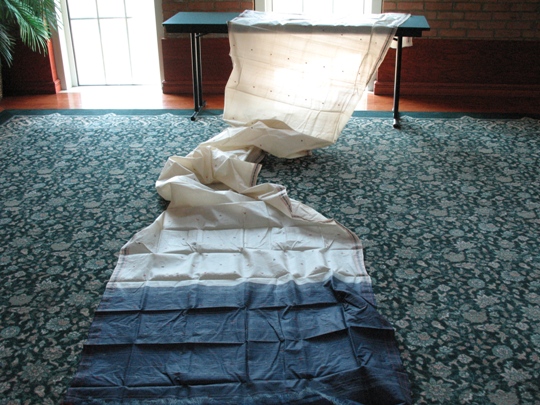
Folding a sari is kind of like folding a map… a map five and a half yards long. It’s carefully folded so that none of the inside parts will show, or snag on things. I didn’t manage to fold it back perfectly, but I got most of it right.
This is a Kosa colored sari (that is: the majority of it is natural, undyed) and the pallau is dyed black. The pallau is the hangy-downy part that shows most when the sari is worn. It has what is called a resham border, which is a supplemental warp pickup, in a pattern of black flowers and red chevron stripes. I’m not sure if that part is Kosa silk, or if it’s mulberry silk – it looks a little finer, and is a distinctly different yarn. The sari is covered throughout with small brocaded patterns called bhutis, or buties. Bhutis are always said to give a sari elegance and charm. This was woven in Raigarh, in the state of Chhattisgarh, India.
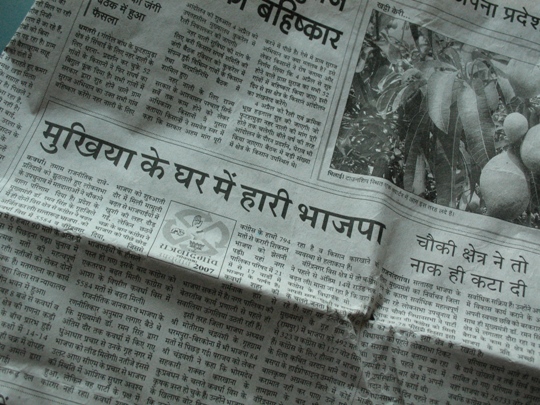
This newspaper was folded into one of the inside folds, to give it a little extra body. It’s in Devanagari, y’all. I have no clue which of the many languages it is in, but it’s probably Chhattisgarhi.
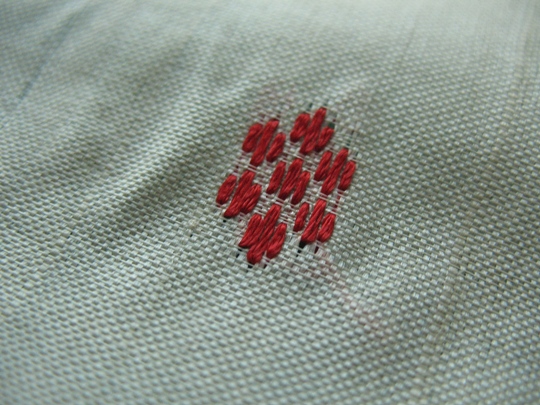
The bhutis are woven in discontinuous weft brocading. For each bhuti in a line across the sari, the weaver will use a separate small shuttle or bobbin of silk. For simple bhutis like this, it might even just be a small bundle of yarn.
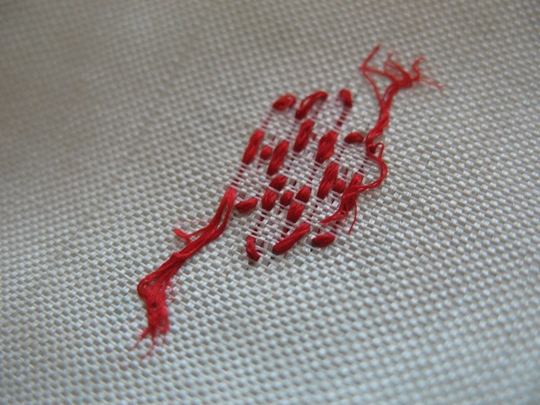
Here’s the back. You can see where they just leave the ends hanging. The weave is tight enough that they don’t seem in danger of pulling loose. I’m not entirely sure if the bhutis are made using the same silk as the border, or if it’s different – it looks like the same dye colors, but the texture and twist are a little different. My guess is, that it’s the same yarn, and it is manipulated during the brocade to take out some of the twist.
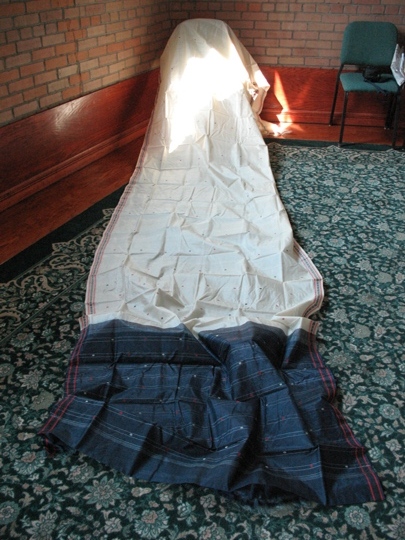
Did I mention that this is a LOT of silk? I’m honestly not sure what governs the lengths of saris, but I’m betting that it’s some traditional length for each region, and the yardage measure is a recent overlay on some pre-British measurement.
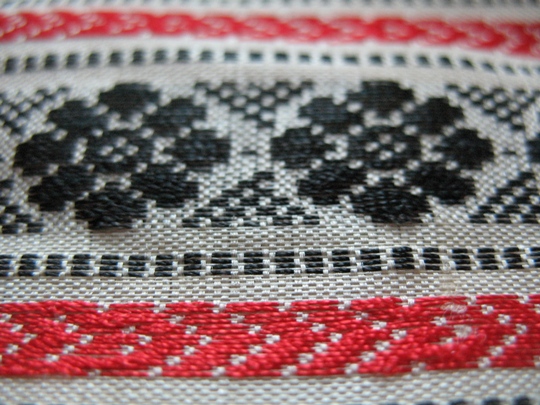
The resham border. You can see the occasional skipped thread, where a shed didn’t entirely clear.
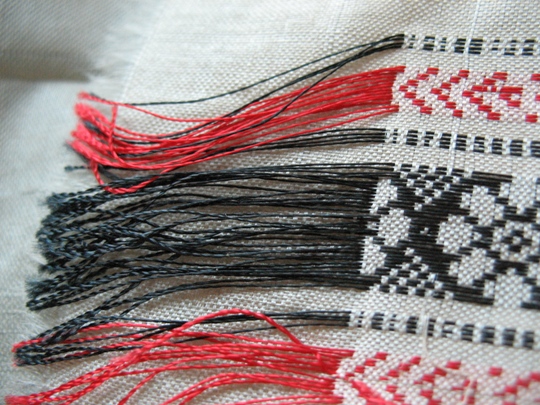
The border pattern ends about an inch and a half shy of the end of the sari, and the rest is plain weave. The ends aren’t fringed, knotted, tied up, hemmed, or anything.
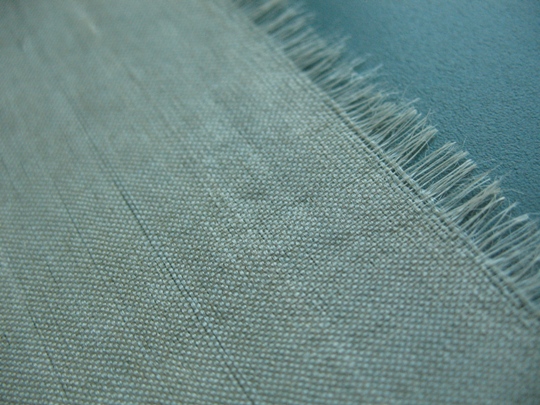
Here’s the edge; it’s trimmed cleanly, but not treated in any way. I’m pretty sure from looking at it under a high-powered lens, that this stuff is totally untwisted reeled filament in both warp and weft.
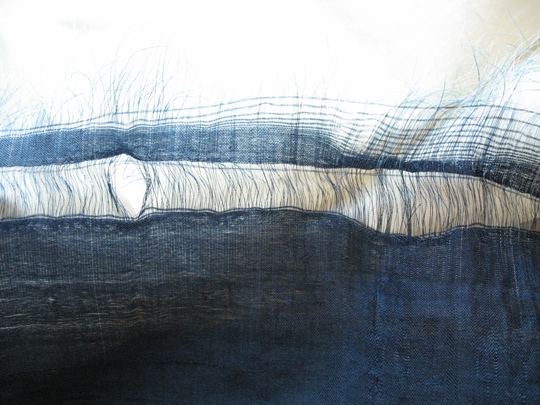
On the pallau end, there is a gap, and then a small woven border. This probably has to do with the way it drapes; the open gap makes it softer.
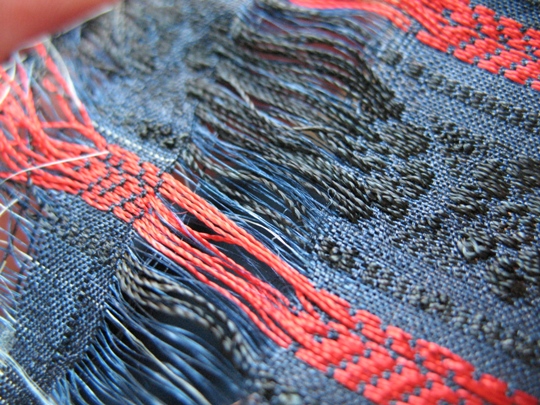
This is the end of the border on the pallau side. The border continues across the gap on this end. You can see the texture of the resham work threads very clearly here; it’s a two-ply shiny silk.
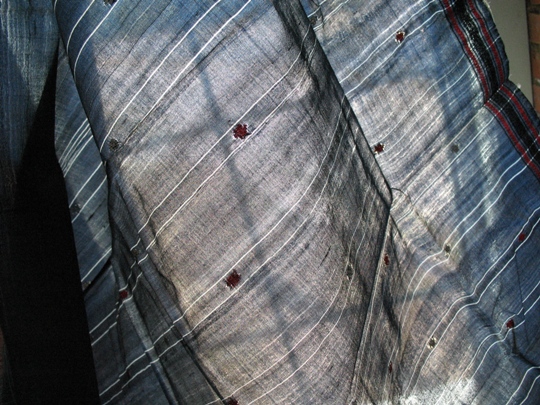
The silk is quite fine; you can see the light coming through it.
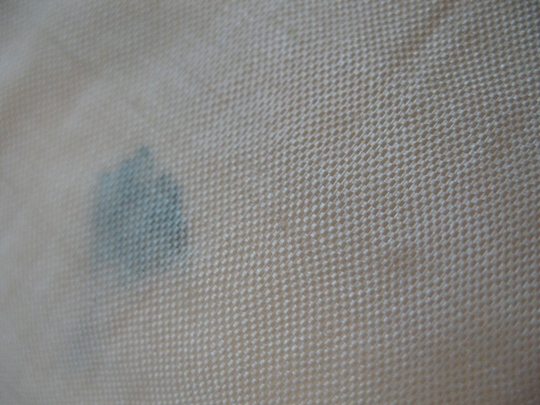
And you can see the bhutis on the layer beneath.
The photos just can’t show the texture of this stuff… you don’t get it until you see and feel it move. So, this is a little video of me crinkling the silk. It has a texture unlike any other fabric. It almost reminds me of a very fine starched cotton, or thin paper, like tissue. It’s stiff, but not at all rough. If you’ve handled a silk dress that has tissue paper stuffed inside it – it’s kind of like that.
I got an amazing deal on this – the cost of the sari was 1299 rupees (about $30) and it cost 1100 rupees (about $26) to ship it. So less than sixty dollars, total, delivered by DHL to my office. The vendor was wonderful about answering my weird questions. If you want to buy one, email me at wormspit@gmail.com and I’ll hook you up with the vendor.

I would love one, but can’t really justify it. Espeically as I don’t know how to wear one, and that is what I would *really* love to do
The internet knows everything:
http://www.exoticindiaart.com/howtowear/
🙂
Yeah, translating that on to *me* though…. 😉
Thanks for the link
Oh, /marvelous/. brought me back one from his India trip; so I know what you mean by the texture and all.)
(
I gave away a green silk sari (with silver) that my grandmother had bought, and I’ll never ever forgive myself!
Thanks for the opening – fun. And the video
Man, what a deal!
And I think that sari lenght is not just by region, but by amount of money you spend? Poor people’s saris aren’t as long as rich peoples?
Sari’s are typically 6 yards according to a former Indian Coworker. Turbans that the men wear are 3 yards.
I love the crinkle crinkle in your video!
I got one of these packages from India. It was so beautifully sewn up that I hated to even cut the stitches. The packaging was almost better than the contents.
Youtube to the rescue!
http://www.youtube.com/watch?v=osiY9AxZtog&feature=related
There’s a couple of nice youtube videos but this one discusses a couple of different styles. 🙂
If this is about your size, then I’ve seen very big women wearing saris, and looking fantastic. If you look at the size of the sari in the picture, you really needn’t worry that you’ll run out of fabric before you get it all the way round you. I have heard that it’s best to get someone who knows what they’re doing to put the sari on you the first time around, though.
What a beautiful sari! I love it.
Re: Youtube to the rescue!
Thankyou so much 🙂
Re: Youtube to the rescue!
God, this is fantastic!
I’m so glad for you! The packaging is less interesting than last time’s though :). I love that crinkling sound too, I’m wondering if it crinkles as one moves wearing it.
Have to say I enjoy reading about you unwrapping your packages from India. Makes me realize just how much I took that style of packaging for granted before 🙂
As for the gap in the pallu, what my grandmother used to do was carefully remove the threads in the small border after the gap and then knot the ends decoratively. Hard to explain what I mean, and I couldn’t find decent pictures on the web, but here’s one that kinda shows what I mean: http://www.ladiestailors.in/images/sari2.jpg
Also, I found that this link below had interesting info on sarees in general, in case you were interested: http://www.xportfashions.com/htmls/saree_sari_wholesale/what_is_sari_saree.htm
I don’t know if you’ve already mentioned this somewhere, but what were you planning on doing with the saree you bought?
Pure silk sarees do make a lovely shushing sound when you move. It always makes me feel all grown up and grand wearing them 🙂
Mainly, I want to have it for display. I do educational programs for schools, museums, and handweavers groups; I like to have different silks from around the world to show and talk about.
I have also considered getting one to cut apart and make a shirt – part of me says that it’s a shame to do that to such a beautiful length of silk, but another part of me says it’d make a spectacular shirt. 🙂
Maybe you could find an old one that someone’s selling that you could do that to? I know old silk sarees would get turned into skirts and things back home when parts of them would wear out and you couldn’t wear them as a saree any more. Unfortunately the only old ones I have are with me for sentimental reasons, otherwise I’d definitely send it your way.
Of course, I’d also be happy to keep an eye out for any that come my way. Any colour preferences or dislikes for shirt purposes?
Thank you! Where is your “back home”? Is it in India or what? (Excuse me if I’m too curious).
Do you use safety pins when you put on a saree? I saw it in Youtube demonstrations, but I’m afraid the pins could damage the silk.
I’ve gotten a couple of old ones that I use for parts of my display; I was just thinking that the Tasar would be particularly cool for a shirt. I usually favor either jewel tones, or the natural colors of the silk. I’d love to have any that you run across that aren’t very expensive – I can get them from India usually for about $18 – $20 for vintage ones with some wear and perhaps a couple of spots.
Back home is India. Funny how I think of it that way even though it’s been way too long since I’ve been back for a visit 🙂 Yes I do use safety pins when I wear a saree. If you use pins that are sharp enough they don’t damage the silk. I use a big one for the front pleats that you tuck in at your waist, and a small one to hold the pallu on my shoulder.
Keeping a saree on without any pins is all in the posture, and I find that if I wear them more frequently the “correct” posture comes naturally, and I feel comfortable not using any at all.
Actually Saris do have a “max size” Because a Sari will have to be “Tailored” (there is way more to it than the fabric) And it will look “wrong” if you don’t get a reasonable amount of pleats into the front of it.
Re: the gap on the pallu end — nope. It is so that they can weave several saris on the same loom/warp. This gives them a secure gap to cut the weaving that won’t affect the tension, or require them to sew it. (or possibly so that they can have some matching thread to sew with – but I doubt that) As mentioned, all loose ends on the Sari will be tailored, skirted, finished, bordered, hemmed, tucked, lined, and crafted. This is also why the ends aren’t tied or knotted… they will be sewn into the actual sari.
I believe the newspaper is in Hindi, and I *think* its says “Village Leader’s house is divided” (or something to that effect)